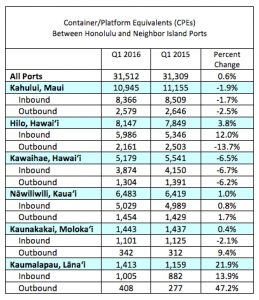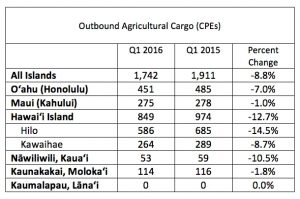Young Bros.: Maui Shipment Volumes Down Slightly

Appendix 1: Shipping volumes for the fourth quarter and year by port. Young Brothers graphic.
Young Brothers Limited’s intrastate cargo shipments between Honolulu and six Neighbor Island ports were essentially flat, increasing slightly (.6 percent), for the first quarter of 2016 compared to the same period in 2015.
For the first three months of 2016, two Neighbor Island ports experienced a decrease in cargo volumes: Kahului, the largest Neighbor Island port in terms of volume, was down 1.9% and Kawaihae on Hawai‘i Island was down 6.5%.
The four remaining Neighbor Island ports experienced gains in cargo volume: Hilo, up 3.8%; Kaua‘i, up 1%; Moloka‘i, up .4%; and Lāna‘i, up 21.9%.
The agricultural sector volumes were down on all islands due to dry weather.
“The first quarter ended with only a modest increase in overall shipments,” said Roy Catalani, vice president of Young Brothers. “So far we aren’t seeing any strong trends emerge and it’s possible that, consistent with our cargo volume projections for the year, this lukewarm first quarter will foreshadow the rest of this year.”
The first-quarter results are on par with the company’s projection for a .4 percent volume increase in
intrastate cargo volumes for all of 2016. The projection was completed by Economist Paul Brewbaker of TZ Economics.
“Recent economic conditions in Hawai‘i’s Neighbor Islands have not been as good as on O‘ahu,” Dr. Brewbaker concluded. “In contrast to the early-2000’s economic expansion when Neighbor Islands
homebuilding was a dominant engine of Hawai‘i economic growth, the Neighbor Islands in the 20 teens are experiencing, and seem likely to continue to experience, relatively muted growth of aggregate output, income and jobs compared to O‘ahu or to national economic experience.”
Cargo volume forecasts change with improving or worsening economic conditions.
Certain sectors and projects positively affected cargo volumes. Major construction companies shipped large volumes of supplies and equipment from Lāna‘i with the completion of resort renovation projects in the first quarter of the year.
Stronger energy-related shipments involved both petroleum and renewable fuel shippers.
Other sectors were mostly flat, with some exceptions. For example, the recycling industry continued to ship less than a year ago, though it is up from the last quarter of 2015.
Agricultural Cargo Volume Down in First Quarter of the Year

Appendix 2: Agricultural cargo volumes for the fourth quarter and 2015 calendar year by port of origin. Young Brothers graphic.
The agricultural sector continued to be challenged by dry weather, making statewide shipments weak for the beginning of 2016.
In the first quarter, intrastate shipments of locally-grown agricultural products decreased by 8.8% compared to the same period last year, with declines at all ports with agricultural exports.
Volumes were down 7% on O‘ahu; down 1% on Maui; down 14.5% in Hilo; down 8.7% in Kawaihae; down 10.5 percent on Kaua‘i; and down 1.8% on Moloka‘i.
The most pronounced drop in agricultural shipments was at the Port of Hilo, which, combined with a smaller drop at the Port of Kawaihae, resulted in a 12.7% year-on-year decline of agricultural products from the Island of Hawai‘i.
Yields of papaya, a dominant crop in the southern part of Hawai‘i Island, have yet to recover from damage during last year’s heavy rains, and large quantities are not expected until later this year.
Agricultural volume includes only cargo that qualifies for the company’s island agricultural product discount of 30 to 35%, which applies to locally grown agricultural products.
For more information, visit www.youngbrothershawaii.com.
Appendix 1 Notes: Young Brothers, Limited Neighbor Island Intrastate Cargo Volume
The “All Ports” category reflects every unique cargo item transported by Young Brothers. In contrast, the sum of individual ports is greater than the amount of unique shipments in the “All Ports” total. This is because transshipment cargo volumes (i.e., cargo that originates on a neighbor island, is transshipped at YB’s Honolulu hub and terminates at another neighbor island port) are attributed to the neighbor island origin port as “outbound” cargo and the neighbor island destination port as “inbound” cargo. Transshipped cargo makes up a relatively small percentage of total cargo volume.
Appendix 2 Notes: Young Brothers, Limited Agricultural Cargo Volume by Island and Port
Agricultural cargo volumes represent all regulated Young Brothers cargo that qualified for the 30% to 35% “Island Product” discount. In contrast to total cargo volumes in Appendix 1, agricultural cargo volumes are categorized only by the port from which they originated, meaning the island on which the agricultural product was grown. Note regarding CPE unit of measurement: Young Brothers measures its cargo in units called “container/platform equivalents” (CPE), which allow a comparison of cargo volumes across different sizes of containers and other non-standardized cargo types.










